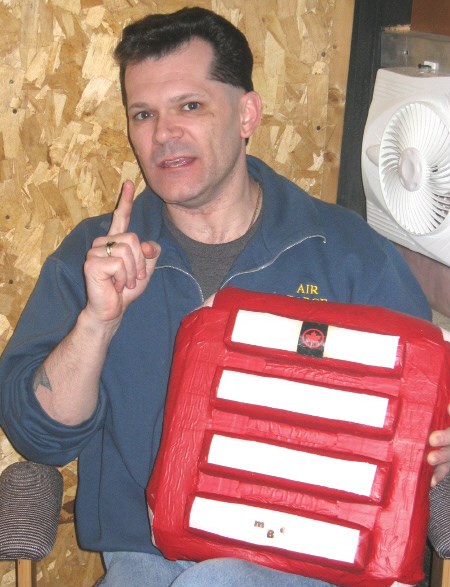North Bay inventor Troy Hurtubise built his Ursus-series suits to protect himself against grizzly bears.
Hurtubise now wants to protect other people and has put the Ursus Mark-VI and Mark-VII up for sale on Ebay to finance his latest invention, the magnetic blast cushion.
He says the cushions, made with specially treated Kevlar, ceramics, metal alloys and the force-absorbing system from the Mark-VII, will shield soldiers in Afghanistan and Iraq from roadside bombs that have already claimed military lives in both countries.
Herculean protection
The cushions can be attached to jeeps, Humvees and other light personnel carriers using magnets. Passengers in the vehicles would also be able to sit on the cushions for added protection.
“They’re able to not only withstand bullets and explosions, but also provide protection from blunt trauma,” said Hurtubise, 39.
“It’s Herculean protection with simplicity.”
Motivated by brother
Hurtubise plans to manufacture 500 of the cushions, 450 of which will go to Canadian troops in Afghanistan.
An American military contact Hurtubise has made will take the other 50 to a select group of US marines in Iraq.
Hurtubise has also offered to equip the entire Canadian contingent in Afghanistan with the blast cushions, free of charge.
"This is for our boys over there," he said.
Each cushion costs about $350 to produce, and Hurtubise said it would take about 34 to cover a military jeep at a total cost of about $12,000.
The bags weigh about seven kg each and covering a Humvee, Hurtubise said, would only add an additional 300 kilograms to the vehicle's weight.
Hurtubise originally wanted to sell his suits to raise money to build the Ursus Mark-VIII.
But he changed his mind because of his younger brother Blair, a private in the Canadian Armed Forces.
They don't have protection
Hurtubise said his concerns started last October when two Canadian soldiers were killed by a landmine in Afghanistan while traveling in Iltis jeeps. Another Canadian soldier driving in the same type of vehicle was killed by a suicide bomber.
“I couldn’t sleep when I heard about those things. I mean that seriously, I love that man so much, my brother, and there’s a possibility that he could be sent over for six months to Afghanistan or Bosnia,” Hurtubise said.
“And they don’t have protection let alone on their bodies but on their vehicles. One of the biggest outcries here is that you’ve got our Canadian army over there and they’re using WW2 Jeeps. I wouldn’t stand for it and that’s when I started this campaign.”
Stronger than steel
Each blast cushion includes 90 layers of Kevlar, 45 of which have been treated with Troy’s fireproof 1313 hardening formula. The layers are then put into a 20-ton press, and the result is a panel “105 times stronger than steel.”
The panel is then attached to a chunk of Excalibur exoskeleton, from the Mark-VII, which, Hurtubise said, is “self-healing” and can absorb blunt trauma without malfunctioning.
Hurtubise said the original materials in the suit have already been tested “with absolutely stunning results” by Med-Eng Systems, a Canadian company in Ottawa, which designs and manufactures personal protective systems for bomb disposal and crowd management.
Med-Eng spokesman John Carson confirmed Hurtubise had done work for the company, but would not release any results due to a non-disclosure agreement.
Secured a site
Hurtubise will conduct further tests June 19 at a site in North Bay north of Roy Road.
“We’re going to have one unprotected Jeep and one with the cushions on it, and then blast them with handguns, shotguns, and M16s and then set up something similar to an attack by rocket-propelled grenades,” Hurtubise said.
"Then we'll see what each one looks like afterwards."
North Bay city administrator David Linkie said Hurtubise would not be contravening any municipal bylaws against the discharge of ordnance if he conducted the tests north of Roy.
Hurtubise has already secured a site in that area and plans to send out invitations to politicians and dignitaries from around the world to witness the testing.
Greatest satisfaction
Tests are great, Hurtubise said, but he's confident
the blast cushions will work in war conditions even if military vehicles are hit by roadside bombs or rocket-propelled grenades.
“I would bet my life today that the soldiers in those vehicles would walk out of it with maybe a dislocated shoulder, broken leg, because I can’ stop all of the percussion, but no shrapnel’s getting through, no bullets getting through, forget it, it won’t happen, and I’ll stake my life on it.”
Hurtubise said his greatest satisfaction will come when his invention actually saves lives in combat.
“I’d love be able to watch on CNN that there’s been a roadside bomb and soldiers for some reason are proclaiming that their lives were saved through this,” Hurtubise said.
“I’d love to see a marine holding up one of the cushions and say ‘if it hadn’t been for this I’d be dead now.’”
Join BayToday+
- Messages
- Post a Listing
- Your Listings
- Your Profile
- Your Subscriptions
- Your Likes
- Your Business
- Support Local News
- Payment History
BayToday+ members
Already a +member?
Not a +member?
Sign up for a BayToday+ account for instant access to upcoming contests, local offers, auctions and so much more.



